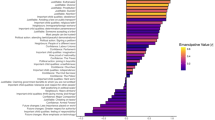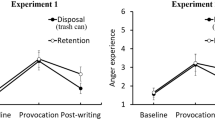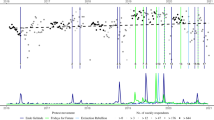Abstract
Violent intergroup conflicts cause widespread harm; yet, throughout human history, destructive hostilities occur time and time again1,2. Benefits that are obtainable by victorious parties include territorial expansion, deterrence and ascendency in between-group resource competition3,4,5,6. Many of these are non-excludable goods that are available to all group members, whereas participation entails substantial individual risks and costs. Thus, a collective action problem emerges, raising the question why individuals participate in such campaigns at all7,8,9. Distinguishing offensive and defensive intergroup aggression provides a partial answer: defensive aggression is adaptive under many circumstances10,11,12,13,14. However, participation in offensive aggression, such as raids or wars of conquest, still requires an explanation. Here, we focus on one condition that is hypothesized to facilitate the emergence of offensive intergroup aggression: asymmetric division of a conflict’s spoils may motivate those profiting from such inequality to initiate between-group aggression, even if doing so jeopardizes their group’s welfare15,16,17. We test this hypothesis by manipulating how benefits among victors are shared in a contest experiment among three Ethiopian societies whose relations are either peaceful or violent. Under equal sharing, between-group hostility increased contest contributions. By contrast, unequal sharing prompted offensive contribution strategies in privileged participants, whereas disadvantaged participants resorted to defensive strategies, both irrespective of group relations.
This is a preview of subscription content, access via your institution
Access options
Access Nature and 54 other Nature Portfolio journals
Get Nature+, our best-value online-access subscription
$29.99 / 30 days
cancel any time
Subscribe to this journal
Receive 12 digital issues and online access to articles
$119.00 per year
only $9.92 per issue
Buy this article
- Purchase on Springer Link
- Instant access to full article PDF
Prices may be subject to local taxes which are calculated during checkout


Similar content being viewed by others
References
Allen, M. W., Bettinger, R. L., Codding, B. F., Jones, T. L. & Schwitalla, A. W. Resource scarcity drives lethal aggression among prehistoric hunter-gatherers in central California. Proc. Natl Acad. Sci. USA 113, 12120–12125 (2016).
Pinker, S. The Better Angels of our Nature. Why Violence has Declined (Viking, New York, NY, 2011).
Gat, A. War in Human Civilization (Oxford Univ. Press, Oxford, 2008).
Glowacki, L., Wilson, M. & Wrangham, R. The evolutionary anthropology of war. J. Econ. Behav. Organ. http://dx.doi.org/10.1016/j.jebo.2017.09.014 (2017).
Wilson, M. L. in War, Peace, and Human Nature (ed. Fry, D. P.) 361–388 (Oxford Univ. Press, Oxford, 2013).
Wrangham, R. W. & Glowacki, L. Intergroup aggression in chimpanzees and war in nomadic hunter-gatherers. Hum. Nat. 23, 5–29 (2012).
Gavrilets, S. Collective action problem in heterogeneous groups. Phil. Trans. R. Soc. B 370, 20150016 (2015).
Mathew, S. & Boyd, R. Punishment sustains large-scale cooperation in prestate warfare. Proc. Natl Acad. Sci. USA 108, 11375–11380 (2011).
Rusch, H. The evolutionary interplay of intergroup conflict and altruism in humans: a review of parochial altruism theory and prospects for its extension. Proc. R. Soc. B 281, 20141539 (2014).
Böhm, R., Rusch, H. & Gürerk, Ö. What makes people go to war? Defensive intentions motivate retaliatory and preemptive intergroup aggression. Evol. Hum. Behav. 37, 29–34 (2016).
de Dreu, C. K. W. et al. In-group defense, out-group aggression, and coordination failures in intergroup conflict. Proc. Natl Acad. Sci. USA 113, 10524–10529 (2016).
Halevy, N. Preemptive strikes: fear, hope, and defensive aggression. J. Pers. Soc. Psychol. 112, 224–237 (2017).
Rusch, H. Asymmetries in altruistic behavior during violent intergroup conflict. Evol. Psychol. 11, 973–993 (2013).
Rusch, H. The two sides of warfare. An extended model of altruistic behavior in ancestral human intergroup conflict. Hum. Nat. 25, 359–377 (2014).
Gavrilets, S. & Fortunato, L. A solution to the collective action problem in between-group conflict with within-group inequality. Nat. Commun. 5, 3526 (2014).
Glowacki, L. & Wrangham, R. W. The role of rewards in motivating participation in simple warfare. Hum. Nat. 24, 444–460 (2013).
Rusch, H. & Gavrilets, S. The logic of animal intergroup conflict: a review. J. Econ. Behav. Organ. https://dx.doi.org/10.1016/j.jebo.2017.05.004 (2017).
Almagor, U. Raiders and elders. A confrontation of generations among the Dassanetch. Senri Ethnol. Stud. 3, 119–145 (1979).
Glowacki, L. & Wrangham, R. Warfare and reproductive success in a tribal population. Proc. Natl Acad. Sci. USA 112, 348–353 (2015).
Walker, R. S. & Bailey, D. H. Body counts in lowland South American violence. Evol. Hum. Behav. 34, 29–34 (2013).
Glowacki, L. Incentives for War in Small-Scale Societies. PhD thesis, Harvard Univ. (2015).
Sääksvuori, L., Mappes, T. & Puurtinen, M. Costly punishment prevails in intergroup conflict. Proc. R. Soc. B 278, 3428–3436 (2011).
Bauer, M. et al. Can war foster cooperation? J. Econ. Perspect. 30, 249–274 (2016).
Schaub, M. Threat and parochialism in intergroup relations: lab-in-the-field evidence from rural Georgia. Proc. R. Soc. B 284, 20171560 (2017).
Weisel, O. & Böhm, R. ‘‘Ingroup love’’ and ‘‘outgroup hate’’ in intergroup conflict between natural groups. J. Exp. Soc. Psychol. 60, 110–120 (2015).
Böhm, R., Rusch, H. & Baron, J. The psychology of intergroup conflict: a review of theories and measures. J. Econ. Behav. Organ. https://doi.org/10.1016/j.jebo.2018.01.020 (2018).
Chen, Y. & Li, S. X. Group identity and social preferences. Am. Econ. Rev. 99, 431–457 (2009).
Konrad, K. A. Strategy and Dynamics in Contests (Oxford Univ. Press, Oxford, 2009).
Glowacki, L. et al. Formation of raiding parties for intergroup violence is mediated by social network structure. Proc. Natl Acad. Sci. USA 113, 12114–12119 (2016).
Centola, D. M. Homophily, networks, and critical mass. Solving the start-up problem in large group collective action. Ration. Soc. 25, 3–40 (2013).
Glowacki, L. & von Rueden, C. Leadership solves collective action problems in small-scale societies. Phil. Trans. R. Soc. B 370, 20150010 (2015).
Boehm, C. Blood Revenge. The Anthropology of Feuding in Montenegro and Other Tribal Societies (Penn Press, Philadelphia, PA, 1984).
Chowdhury, S. M. & Sheremeta, R. M. A generalized Tullock contest. Public Choice 147, 413–420 (2011).
Kimbrough, E. O., Laughren, K. & Sheremeta, R. War and conflict in economics: theories, applications, and recent trends. J. Econ. Behav. Organ. https://dx.doi.org/10.1016/j.jebo.2017.07.026 (2017).
Ryvkin, D. Tullock contests of weakly heterogeneous players. Public Choice 132, 49–64 (2007).
Dechenaux, E., Kovenock, D. & Sheremeta, R. M. A survey of experimental research on contests, all-pay auctions and tournaments. Exp. Econ. 18, 609–669 (2015).
Sheremeta, R. M. Overbidding and heterogeneous behavior in contest experiments. J. Econ. Surv. 27, 491–514 (2013).
Sheremeta, R. M. Behavior in group contests. A review of experimental research. J. Econ. Surv. https://doi.org/10.1111/joes.12208 (2017).
Falk, A. & Heckman, J. J. Lab experiments are a major source of knowledge in the social sciences. Science 326, 535–538 (2009).
Kessler, J. B. & Vesterlund, L. in Handbook of Experimental Economic Methodology (eds Fréchette, G. R. & Schotter, A.) 391–406 (Oxford Univ. Press, Oxford, 2015).
Wiessner, P. Experimental games and games of life among the Ju/’hoan Bushmen. Curr. Anthropol. 50, 133–138 (2009).
Glowacki, L. & Molleman, L. Subsistence styles shape human social learning strategies. Nat. Hum. Behav. 1, 0098 (2017).
Yntiso, G. in Creating and Crossing Boundaries in Ethiopia (ed. Epple, S.) 49–71 (LIT, Zürich, 2014).
Tornay, S. Armed conflicts in the lower Omo Valley, 1970–1976. An analysis from within Nyangatom society. Senri Ethnol. Stud. 3, 97–117 (1979).
Acknowledgements
We thank M. Albert, R. Böhm, T. Friehe, M. Greiff, M. Hoffman, R. Ligtvoet, F. Morath, K. M. Zimmermann and the audiences at MPI Bonn, NCBEE 2016 Oslo, ESA 2016 Bergen, GfeW 2016 Giessen and MACIE Marburg for helpful comments and suggestions. G.D. gratefully acknowledges financial support by the Dr. Jürgen Meyer Foundation. H.R. gratefully acknowledges financial support by VU Amsterdam. L.G. gratefully acknowledges support from the Eric M. Mindich Research Fund for the Foundations of Human Behavior, the Mind Brain and Behavior Interfaculty Initiative at Harvard University and the ANR Labex IAST. This work was assisted through participation of L.G. and H.R. in the ‘Evolution & Warfare’ Investigative Workshop at NIMBIOS, sponsored by the National Science Foundation through the NSF Award no. DBI-1300426, with additional support from the University of Tennessee, Knoxville, Tennessee, USA. The funders had no role in study design, data collection and analysis, decision to publish or preparation of the manuscript.
Author information
Authors and Affiliations
Contributions
All authors contributed equally to this work and are listed alphabetically.
Corresponding authors
Ethics declarations
Competing interests
The authors declare no competing interests.
Additional information
Publisher’s note: Springer Nature remains neutral with regard to jurisdictional claims in published maps and institutional affiliations.
Supplementary information
Supplementary Information
Supplementary Figures 1–3, Supplementary Tables 1–6, Supplementary Note
Rights and permissions
About this article
Cite this article
Doğan, G., Glowacki, L. & Rusch, H. Spoils division rules shape aggression between natural groups. Nat Hum Behav 2, 322–326 (2018). https://doi.org/10.1038/s41562-018-0338-z
Received:
Accepted:
Published:
Issue Date:
DOI: https://doi.org/10.1038/s41562-018-0338-z
This article is cited by
-
Leader–follower behavioural coordination and neural synchronization during intergroup conflict
Nature Human Behaviour (2023)
-
How does relative deprivation relate to aggression in young male migrant workers? The mediator of self-esteem
Current Psychology (2023)



